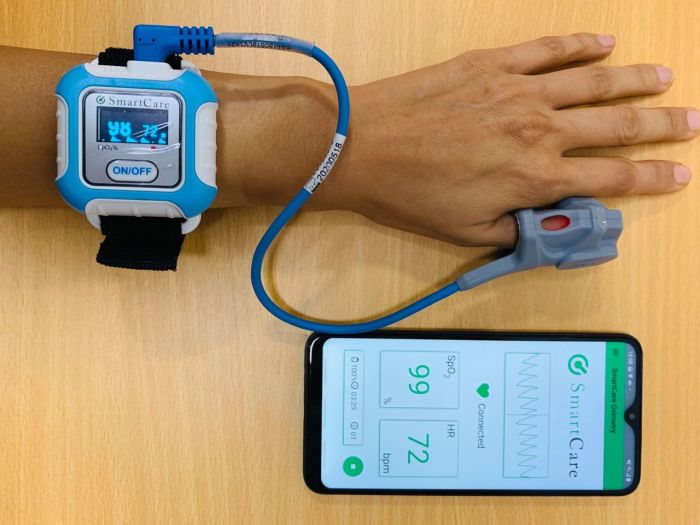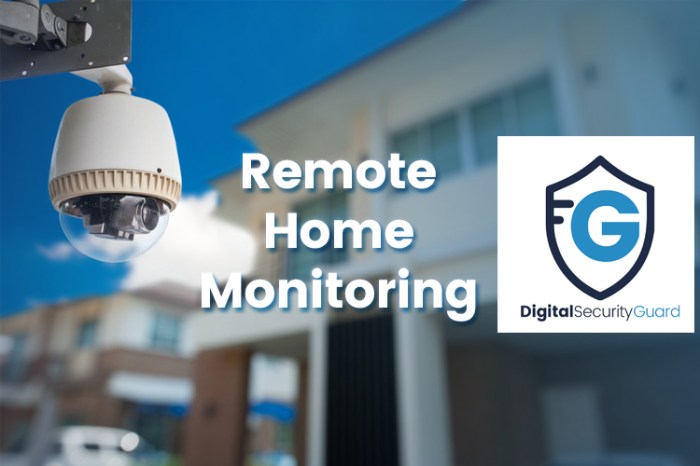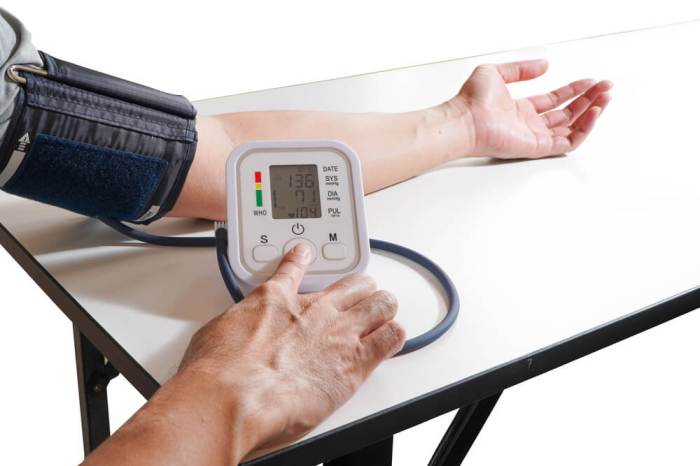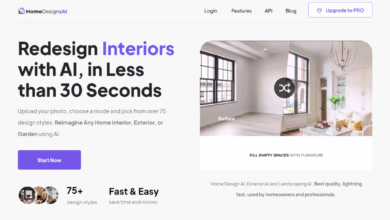Remote Home Monitoring A Comprehensive Guide
Remote Home Monitoring offers unparalleled peace of mind, transforming how we secure and manage our homes. From basic security systems to sophisticated smart home integrations, the technology provides a wide range of options to suit diverse needs and budgets. This guide explores the various types of systems available, their components, applications, and the crucial aspects of security and privacy.
We’ll delve into the intricacies of DIY setups versus professionally monitored systems, examining the features, costs, and ease of installation for each. We’ll also explore how remote monitoring extends beyond security, encompassing elderly care, energy management, and home automation. By understanding the technology’s capabilities and limitations, you can make informed decisions to best protect your home and loved ones.
Types of Remote Home Monitoring Systems

Source: bmj.com
Remote home monitoring systems offer peace of mind and enhanced security, but choosing the right system depends on individual needs and technical expertise. Several categories exist, each with distinct features, costs, and levels of complexity. Understanding these differences is crucial for making an informed decision.
DIY Remote Home Monitoring Systems
DIY systems empower users to install and manage their home security without professional intervention. These systems typically consist of a central hub, various sensors (door/window sensors, motion detectors, etc.), and a mobile application for monitoring and control. They offer a cost-effective entry point into home security, but lack the professional monitoring services found in other categories. Installation is generally straightforward, often involving simple plug-and-play components.
Examples include SimpliSafe, which offers a range of customizable kits with various sensor options, and Abode, known for its flexible and user-friendly interface. These systems often rely on cellular or Wi-Fi connectivity for communication.
Professionally Monitored Remote Home Monitoring Systems
Professionally monitored systems provide a higher level of security by connecting directly to a central monitoring station. In case of an alarm triggered by a sensor, a monitoring agent is immediately notified and can dispatch emergency services if necessary. This adds a significant layer of security beyond DIY systems. While these systems typically have a higher initial cost and recurring monthly fees, the peace of mind offered by professional monitoring is a major advantage.
Companies like ADT and Vivint offer comprehensive professionally monitored systems, often including professional installation and 24/7 monitoring services. These systems usually employ advanced features like professional-grade sensors and more robust communication protocols.
Smart Home Integrated Remote Home Monitoring Systems
These systems integrate seamlessly with other smart home devices and platforms, allowing for centralized control and automation. This can include linking the security system with lighting, thermostats, and other smart home devices to create a comprehensive, interconnected ecosystem. Many smart home hubs, like Amazon Alexa and Google Home, can be integrated with security systems, allowing for voice control and enhanced automation.
For instance, you could set up your system to automatically turn on lights when a motion sensor is triggered, or receive alerts through your smart speaker. Companies like Ring and Nest offer security systems that integrate well with other smart home ecosystems, often offering a comprehensive suite of products for various home automation needs.
Comparison of Prominent Home Monitoring Systems
The following table compares three prominent systems across key features:
| System | Price (approx.) | Features | Ease of Installation | Monthly Fee (approx.) |
|---|---|---|---|---|
| SimpliSafe | $200 – $500 | Various sensor options, mobile app control, self-monitoring | Easy | $15 – $30 |
| ADT | $500 – $1500+ (installation included) | Professional monitoring, advanced sensors, professional installation, 24/7 support | Professional Installation | $30 – $60+ |
| Ring Alarm | $200 – $400 | DIY installation, app control, smart home integration, video doorbell compatibility | Easy to Moderate | $10 – $20 |
Essential Components of a Remote Home Monitoring System
A robust remote home monitoring system relies on the seamless integration of several key hardware and software components. These components work together to provide comprehensive surveillance, security, and control over your home, even when you’re away. Understanding their individual functions and their interconnectedness is crucial for choosing and effectively utilizing a system.
The core functionality of a remote home monitoring system hinges on the interplay between sensors, cameras, a control panel, and a central monitoring hub. These components gather data, process information, and allow for remote access and control. Reliable network connectivity and robust data security measures are also essential for the system’s overall effectiveness and safety.
Core Hardware Components
The basic components of a remote home monitoring system include a range of sensors, cameras, and a control panel, all communicating with a central hub. These components offer different functionalities that combine to provide a complete home security and monitoring solution.
Sensors play a vital role in detecting various events within the home. These can range from simple motion detectors to more sophisticated environmental sensors. Cameras provide visual monitoring, offering a direct view of activity within the home. The control panel acts as the central interface for the system, allowing users to arm/disarm the system, view camera feeds, and manage various settings.
Remote home monitoring systems offer peace of mind, allowing users to check in on their property from anywhere. This technology’s principles extend to larger scales, influencing the design of commercial spaces; consider the sophisticated security systems often incorporated into modern office buildings, a key element of what’s offered by firms specializing in Commercial Interior Design. Ultimately, both residential and commercial applications share a common goal: providing a secure and monitored environment.
Finally, the central monitoring hub acts as the brain of the operation, receiving data from all components, processing it, and making it accessible remotely.
Sensor Functionality and Interaction
Motion detectors, for example, use infrared technology to detect movement and trigger alerts. Door/window sensors detect openings, providing immediate notification of unauthorized entry. Smoke and carbon monoxide detectors safeguard against potential hazards, while environmental sensors can monitor temperature and humidity levels. These sensors transmit data wirelessly (often via Wi-Fi or Z-Wave) to the central hub, which then relays this information to the user’s mobile device or computer.
The interaction between sensors ensures comprehensive coverage and allows for a multi-layered security approach.
Camera Functionality and Interaction
Cameras provide a visual component to the monitoring system, offering real-time video feeds from various locations within the home. Many modern cameras include features such as night vision, motion detection, and two-way audio. Similar to sensors, cameras transmit their data wirelessly to the central hub, which stores the footage and makes it accessible remotely through a dedicated app or web interface.
Integration with other components allows for automated responses; for instance, a camera detecting motion might trigger a siren or alert the user’s mobile device.
Control Panel Functionality and Interaction
The control panel serves as the primary interface for managing the entire system. It allows users to arm and disarm the security system, review sensor data, and access camera feeds. Advanced control panels may offer additional features such as automated scheduling, integration with smart home devices, and remote access control. The control panel communicates wirelessly with the central hub and other components, facilitating seamless system management.
Network Connectivity and Data Security
Reliable network connectivity is paramount for the effective functioning of a remote home monitoring system. A stable internet connection ensures seamless data transmission between components and the central hub, allowing for real-time monitoring and control. The system’s security is equally critical; robust encryption protocols must be in place to protect sensitive data from unauthorized access. This includes secure data transmission, strong passwords, and regular software updates to address potential vulnerabilities.
Consideration should be given to features such as two-factor authentication and data encryption to enhance security.
System Communication Flow Diagram, Remote Home Monitoring
Imagine a diagram depicting a home with several sensors (door/window sensors, motion detectors, smoke detectors) and cameras strategically placed in key areas. These components wirelessly transmit data to a central hub, typically a small device connected to the home’s router. This hub then communicates with a cloud-based server (for remote access) and the user’s smartphone or computer via a secure connection (e.g., using HTTPS).
The user can then view live feeds, receive alerts, and control system settings through the user interface. The communication flow is essentially a two-way street, allowing the user to interact with and control the system remotely.
Applications and Use Cases of Remote Home Monitoring
Remote home monitoring systems offer a wide range of applications beyond basic security, extending into areas like healthcare, energy management, and home automation. These systems provide valuable insights and control, enhancing convenience and safety for homeowners and their families. The versatility of these systems allows for tailored solutions to meet diverse individual needs.
Enhanced Home Security
Remote home monitoring significantly bolsters home security by providing real-time alerts and remote control capabilities. Imagine a system that instantly notifies you of any unusual activity, such as a broken window or an unauthorized entry. This immediate awareness allows for prompt responses, potentially deterring criminals and minimizing property damage. Furthermore, many systems integrate with smart locks, allowing you to remotely lock or unlock doors, even when away from home.
For instance, a family on vacation could receive an alert if a window sensor is triggered, and then use the app to check their security cameras and ensure everything is safe. This peace of mind is invaluable. Another example is the use of motion detectors that send alerts to your phone, enabling you to check live feeds from security cameras to assess the situation before calling the authorities.
Elderly Care and Remote Health Monitoring
Remote home monitoring plays a crucial role in supporting independent living for the elderly while providing peace of mind for family members. Systems can track vital signs, detect falls, and monitor activity levels, providing crucial data to healthcare providers and family caregivers. For example, a system could detect a fall and automatically alert emergency services and designated family contacts.
This immediate response can be lifesaving. Furthermore, regular monitoring of activity levels can help identify potential health issues early on, allowing for timely intervention. A scenario might involve an elderly individual’s reduced movement being detected, prompting a check-in call from a family member or healthcare professional, leading to the discovery of an undiagnosed illness.
Energy Consumption Management and Improved Home Automation
Remote home monitoring systems contribute to energy efficiency by providing detailed insights into energy usage patterns. Smart thermostats, for example, learn your preferences and adjust temperatures accordingly, optimizing energy consumption. This data allows homeowners to identify areas of high energy use and implement energy-saving measures. A family could use the data to understand how much energy their appliances consume, leading to the decision to replace older, less efficient appliances.
Remote home monitoring offers peace of mind, allowing you to check in on your property from anywhere. A key aspect to consider is the overall aesthetic; after all, you’ll likely be viewing your home’s interior, so a well-designed space is important. For instance, a thoughtfully planned living room, such as those showcased in examples from Living Room Interior Design , can enhance the viewing experience and overall sense of security.
Ultimately, effective remote home monitoring integrates seamlessly with your home’s design.
Beyond energy monitoring, these systems often integrate with other smart home devices, creating a fully automated home environment. Imagine a system that automatically adjusts lighting based on occupancy, turns off appliances when not in use, and manages irrigation systems based on weather conditions, all controlled remotely via a smartphone app. This level of automation not only saves energy but also enhances convenience and comfort.
Setting up and Managing a Remote Home Monitoring System

Source: digitalsecurityguard.com
Setting up and managing a DIY remote home monitoring system can seem daunting, but with a systematic approach, it’s a manageable process. This section details the steps involved in installation, configuration, remote access, and security best practices, empowering you to effectively monitor your home remotely. The process involves selecting appropriate hardware and software, installing the components, configuring alerts, and regularly reviewing the system’s security.
Installing a DIY Remote Home Monitoring System
The installation process for a typical DIY system involves several key steps. First, you need to choose the location for your central hub, considering factors such as Wi-Fi signal strength and power access. Then, you’ll need to connect the hub to your home’s network and power source, usually a straightforward plug-and-play process. Next, install any sensors (motion detectors, door/window sensors, etc.) following the manufacturer’s instructions.
These typically involve attaching them to surfaces using adhesive strips or screws. Finally, download and install the associated mobile application on your smartphone or tablet, and register your system following the app’s guidance. This often involves creating an account and linking your system to the app.
Remote home monitoring offers peace of mind, allowing you to check in on your property from anywhere. However, a well-designed interior can also enhance security features, and for optimal integration, consider professional guidance. For instance, you might consult with an expert from Interior Design Consultation to ensure your smart home devices are seamlessly incorporated into your aesthetic.
Ultimately, this holistic approach improves both the functionality and appearance of your remote home monitoring system.
Configuring Alerts and Notifications
Customizing alerts and notifications is crucial for effective remote home monitoring. Within the mobile application, you can typically specify which sensors trigger alerts and what type of notification you receive (push notification, email, SMS). For instance, you can configure a motion sensor in your living room to send you an instant push notification to your phone if motion is detected after a certain time.
Similarly, you can set up alerts for door or window openings, unusual temperature changes, or even water leaks, depending on the sensors in your system. You can also adjust the sensitivity of these alerts to reduce false alarms.
Accessing and Reviewing Recorded Footage or Sensor Data Remotely
Most systems allow for remote access to recorded footage (if you have cameras) and sensor data via a dedicated mobile application. The app usually provides a live feed from your cameras, allowing you to view your home in real-time. Recorded footage can typically be accessed and reviewed through the app’s interface, often organized by date and time. Sensor data, such as door/window activity or temperature readings, is usually presented in a user-friendly format, often graphically represented over time, allowing you to easily track activity and identify trends.
Many systems offer cloud storage for recorded footage and sensor data, allowing access even if your home network is unavailable.
Remote home monitoring offers peace of mind, allowing you to check in on your property from anywhere. This is particularly appealing when designing a home with a focus on clean lines and functionality, such as a space inspired by Minimalist Interior Design. A minimalist aesthetic often prioritizes smart technology integration, making remote monitoring systems a natural and unobtrusive addition to the overall design.
Maintaining System Security and Preventing Unauthorized Access
Maintaining the security of your remote home monitoring system is paramount. Here are some best practices:
- Strong Passwords: Use strong, unique passwords for your system’s hub and mobile application. Avoid using easily guessable passwords or reusing passwords from other accounts.
- Regular Software Updates: Keep the system’s firmware and mobile application updated to the latest versions. Updates often include security patches that address vulnerabilities.
- Two-Factor Authentication (2FA): Enable 2FA whenever possible. This adds an extra layer of security, requiring a second verification method (like a code from your phone) in addition to your password.
- Secure Network: Ensure your home Wi-Fi network is secured with a strong password and encryption (WPA2/WPA3).
- Regular Security Audits: Periodically review your system’s security settings and access logs to identify any potential issues or unauthorized access attempts.
- Firewall: Consider using a firewall to further protect your system from external threats.
Privacy and Security Concerns Related to Remote Home Monitoring
Remote home monitoring systems, while offering significant convenience and security benefits, also raise legitimate concerns about the privacy and security of personal data. The constant collection and transmission of information about your home and its occupants necessitates a careful consideration of potential vulnerabilities and the steps needed to mitigate them. This section will explore these concerns and Artikel practical measures to protect your privacy.
Data Collection and Storage Risks
The continuous stream of data generated by remote home monitoring systems—from video footage to sensor readings—presents a significant privacy risk. Unauthorized access to this data could expose sensitive information about your daily routines, personal belongings, and even family members. Data breaches, whether through hacking or internal vulnerabilities, could lead to identity theft, stalking, or other serious consequences. Furthermore, the storage of this data, even with reputable providers, carries inherent risks.
Remote home monitoring offers peace of mind, allowing you to check in on your property from anywhere. However, integrating smart home features often necessitates thoughtful consideration of your home’s overall aesthetic, which is where expertise in Interior Design Renovation can prove invaluable. A well-planned renovation can seamlessly incorporate these technologies while enhancing your home’s style, ultimately improving both security and the overall living experience with your remote monitoring system.
Data stored in the cloud, for instance, is susceptible to various threats, including server vulnerabilities and accidental data leaks. Robust security measures are paramount to safeguard against these risks.
Mitigating Privacy Risks Through Encryption and Access Control
Effective mitigation strategies are crucial to address the privacy risks associated with remote home monitoring. Data encryption, a fundamental security practice, plays a critical role in protecting data both in transit and at rest. Strong encryption algorithms, such as AES-256, render intercepted data unintelligible to unauthorized individuals. Furthermore, robust access control mechanisms, including multi-factor authentication and role-based access, limit access to sensitive data to authorized personnel only.
This prevents unauthorized individuals from accessing or modifying the data, even if they gain access to the system. Regular software updates and security patches are also essential to address any vulnerabilities that might emerge over time.
Choosing Reputable Providers with Strong Security Protocols
Selecting a reputable provider is a cornerstone of secure remote home monitoring. Reputable companies invest heavily in robust security infrastructure, employing experienced cybersecurity professionals and implementing industry-best practices. Look for providers that adhere to recognized security standards, such as ISO 27001, and have transparent security policies readily available. Scrutinize their privacy policies to understand how they collect, use, and protect your data.
Providers with a proven track record of security and a commitment to data protection are significantly less likely to compromise your privacy.
Comparison of Data Encryption Methods
Various encryption methods are employed in remote home monitoring systems, each with varying levels of security. AES (Advanced Encryption Standard), particularly AES-256, is a widely used and highly secure algorithm, offering robust protection against unauthorized access. RSA (Rivest-Shamir-Adleman) is another common encryption method, often used for key exchange and digital signatures. While both are strong encryption methods, AES-256 is generally considered more suitable for encrypting large volumes of data, such as video feeds, due to its superior speed and efficiency.
The choice of encryption method depends on factors such as the volume of data, the level of security required, and the processing power available. Choosing a system that utilizes a widely accepted and robust encryption method like AES-256 is essential for optimal security.
Future Trends in Remote Home Monitoring Technology

Source: smartclinix.net
Remote home monitoring is rapidly evolving, driven by advancements in various technologies and a growing demand for enhanced security, convenience, and energy efficiency. The integration of artificial intelligence and machine learning, coupled with the proliferation of IoT devices, is poised to revolutionize the capabilities and user experience of these systems. This section explores the key technological trends shaping the future of remote home monitoring.
Emerging Technologies Impacting Remote Home Monitoring
Several emerging technologies are set to significantly influence the future landscape of remote home monitoring. These include advancements in sensor technology, offering improved accuracy and sensitivity; the development of low-power wide-area networks (LPWANs) for reliable long-range connectivity; and the increasing sophistication of edge computing, allowing for faster processing and reduced reliance on cloud infrastructure. For instance, the use of advanced sensor fusion techniques will enable systems to more accurately interpret data from multiple sensors, improving the overall reliability and responsiveness of the system.
The expansion of LPWAN technologies like LoRaWAN and NB-IoT will facilitate the deployment of larger networks of sensors, especially in areas with limited connectivity.
Artificial Intelligence and Machine Learning Integration
The integration of AI and ML is transforming remote home monitoring systems from simple alert generators to proactive and intelligent platforms. AI algorithms can analyze vast amounts of data from various sensors to detect anomalies, predict potential issues, and provide personalized insights. For example, an AI-powered system could learn the typical energy consumption patterns of a home and alert the user to any significant deviations, indicating potential appliance malfunctions or energy waste.
Machine learning models can also be trained to identify and classify security threats more accurately, reducing false alarms and improving response times. This proactive approach enhances both security and energy efficiency.
Evolution of System Functionalities and User Interfaces
Future remote home monitoring systems will likely offer more sophisticated functionalities and intuitive user interfaces. We can expect more seamless integration with other smart home devices and services, creating a truly interconnected ecosystem. Personalized dashboards will provide users with customized information and alerts, tailored to their specific needs and preferences. Furthermore, the use of voice assistants and augmented reality interfaces will streamline interaction with the system, making it more accessible and user-friendly.
For instance, a user could simply ask their voice assistant to check the status of their security system or adjust the temperature in a specific room.
A Futuristic Vision of Seamlessly Integrated Smart Home Monitoring
Imagine a future where your home anticipates your needs before you even realize them. A seamlessly integrated smart home monitoring system, powered by advanced AI and interconnected devices, proactively manages energy consumption, enhances security, and provides personalized comfort. The system learns your daily routines, adjusts lighting and temperature automatically, alerts you to potential hazards, and even interacts with other smart devices to optimize your home environment.
This system isn’t just about monitoring; it’s about creating a proactive and intelligent home that adapts to your lifestyle, ensuring safety, comfort, and efficiency with minimal user intervention. This represents a shift from reactive monitoring to predictive and preventative management of the home environment.
Summary: Remote Home Monitoring
Ultimately, remote home monitoring represents a significant advancement in home security and management. While privacy and security concerns are valid and require careful consideration, the benefits—enhanced safety, convenience, and control—are undeniable. By carefully selecting a system that aligns with your specific needs and prioritizing data security, you can leverage this technology to create a safer, smarter, and more efficient home environment.
The future of remote home monitoring promises even greater integration with AI and other smart technologies, further enhancing its capabilities and accessibility.
Clarifying Questions
What is the average lifespan of a remote home monitoring system?
The lifespan varies depending on the system’s components and quality. However, a well-maintained system can typically last 5-10 years.
Can I use my existing Wi-Fi network for remote monitoring?
Most systems utilize your existing Wi-Fi network, but some may require a dedicated connection for optimal performance and reliability. Check the system’s specifications.
What happens if my internet connection goes down?
Functionality will be limited. Some systems offer backup options like cellular connectivity, while others may rely on a local alarm system until internet is restored.
How much does professional monitoring cost?
Costs vary significantly based on the service provider and the level of monitoring required. Expect to pay a monthly fee, typically ranging from $20 to $50 or more.
What are the legal implications of recording video footage of my property?
Laws regarding video surveillance vary by location. It’s crucial to understand and comply with local regulations regarding recording and data storage.










